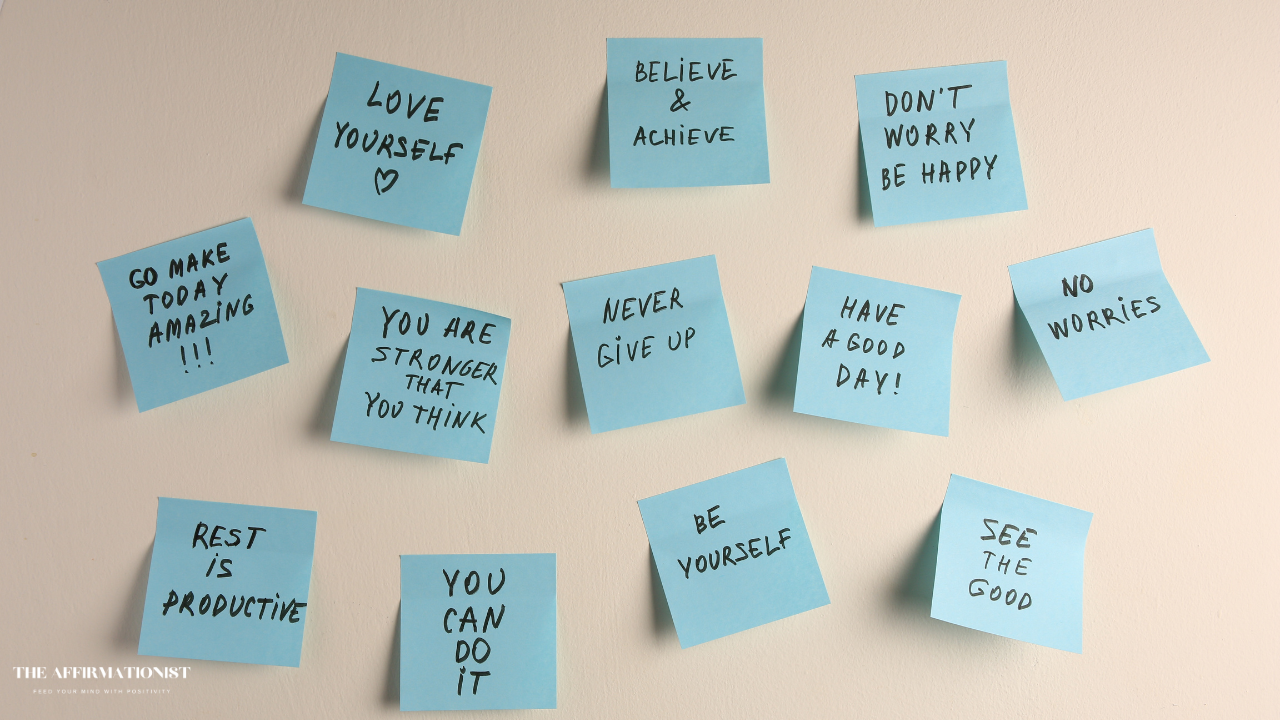Change is the only constant in life. Whether it’s a new job, a relocation, a relationship shift, or simply the natural progression of time, change is an inevitable part of the human experience. While some embrace change with open arms, many others find it unsettling and even frightening. This is where the power of affirmations can be truly transformative.
Understanding the Power of Affirmations

Affirmations are more than just positive statements; they are powerful tools that tap into the intricate workings of our minds, influencing our thoughts, beliefs, and ultimately, our reality. To truly grasp their power, we need to understand the underlying mechanisms at play:
1. The Neuroscience of Affirmations: Rewiring the Brain
Our brains are incredibly adaptable, a characteristic known as neuroplasticity. This means that our neural pathways, the connections between neurons, can change and reorganize throughout our lives. Our thoughts and experiences shape these pathways. When we repeatedly think negative thoughts, these pathways become stronger, making it easier to fall into negative thought patterns.
Affirmations work by creating new, positive neural pathways. When you consistently repeat positive statements, you are essentially “exercising” these new pathways, making them stronger and more dominant over time. This process weakens the old, negative pathways, making it less likely that you’ll automatically revert to negative thinking. Think of it like learning a new skill – the more you practice, the better you become, and the stronger the neural connections associated with that skill become.
2. The Subconscious Mind: The Seat of Beliefs
Our subconscious mind is a powerful force that operates beneath our conscious awareness. It stores our memories, beliefs, habits, and automatic responses. Many of our deeply ingrained beliefs about ourselves and the world are housed within the subconscious. These beliefs often dictate our behavior and reactions, even without us realizing it.
Affirmations bypass the conscious mind and directly target the subconscious. By repeatedly feeding the subconscious positive messages, we can gradually reprogram deeply held beliefs that may be hindering our ability to embrace change. For example, if you subconsciously believe you are not adaptable, facing a new job will trigger anxiety. However, consistently affirming “I am adaptable and thrive in new environments” can gradually shift this belief, leading to a more positive and confident experience.
3. The Law of Attraction: Aligning with Positive Energy
The Law of Attraction suggests that like attracts like. This means that our thoughts and beliefs, whether positive or negative, attract corresponding experiences into our lives. When we focus on positive affirmations, we are essentially emitting positive energy, which in turn attracts positive outcomes and opportunities.
When facing change, fear and negativity can create a self-fulfilling prophecy. If you constantly worry about failing in a new role, you are more likely to experience setbacks. Conversely, using affirmations to cultivate a positive mindset can help you attract the resources, support, and opportunities needed to succeed.
4. Boosting Self-Efficacy and Confidence:
Self-efficacy, the belief in your ability to succeed in specific situations or accomplish a task, is crucial for navigating change. Affirmations directly contribute to boosting self-efficacy by reminding you of your strengths, capabilities, and past successes.
When facing a new challenge, self-doubt can be paralyzing. Affirmations act as a powerful antidote, reminding you that you have the inner resources to handle the situation. For instance, affirming “I am capable of overcoming any obstacle” reinforces your belief in your resilience and empowers you to take action despite fear or uncertainty.
5. Reducing Stress and Anxiety:
Change often triggers stress and anxiety due to the uncertainty and perceived lack of control. Affirmations can act as a powerful stress management tool by shifting your focus from fear and worry to hope and possibility.
Repeating affirmations like “I am calm and centered in the face of change” can help regulate your nervous system, reduce feelings of anxiety, and promote a sense of inner peace. This allows you to approach challenges with a clearer mind and make more effective decisions.
How Affirmations Work for Embracing Change

Affirmations are powerful tools for navigating change because they directly address the mental and emotional hurdles that often accompany transitions. Here’s a deeper look at how they work specifically in the context of embracing change:
1. Counteracting Resistance to Change:
Change, even positive change, can trigger resistance. This resistance often stems from fear of the unknown, discomfort with leaving our comfort zone, or a perceived loss of control. Affirmations act as a gentle yet persistent force to counteract this resistance.
- Shifting Focus from Fear to Opportunity: Instead of dwelling on what might go wrong, affirmations redirect your attention to the potential benefits and opportunities that change can bring. For example, if you’re facing a job loss, affirming “New doors of opportunity are opening for me” can help you shift from a mindset of fear to one of anticipation.
- Building Acceptance and Openness: Affirmations can help you cultivate a more accepting and open attitude towards change. By repeatedly affirming “I embrace change and trust the process of life,” you begin to internalize the idea that change is a natural and inevitable part of life, rather than something to be resisted.
2. Enhancing Adaptability and Resilience:
Adaptability, the ability to adjust to new conditions, and resilience, the capacity to recover quickly from difficulties, are crucial for navigating change successfully. Affirmations can play a significant role in enhancing both of these qualities.
- Strengthening Belief in Your Ability to Adapt: Affirmations like “I am adaptable and easily adjust to new situations” reinforce your belief in your capacity to handle new circumstances. This increased self-belief empowers you to take on challenges with greater confidence.
- Promoting a Growth Mindset: A growth mindset is the belief that your abilities and intelligence can be developed through effort and learning. Affirmations such as “I learn and grow from every experience” foster a growth mindset, which is essential for viewing change as an opportunity for personal development.
- Cultivating Inner Strength and Resilience: Change can be stressful and emotionally taxing. Affirmations like “I am strong, resilient, and capable of overcoming any challenge” help you tap into your inner strength and resilience, providing you with the emotional fortitude to weather any storm.
3. Managing Uncertainty and Anxiety:
Uncertainty is a common companion of change, and it can often lead to anxiety and worry. Affirmations can help you manage these feelings by providing a sense of grounding and reassurance.
- Promoting a Sense of Control: While you can’t control the change itself, affirmations can help you regain a sense of control over your response to it. By affirming “I am in control of my thoughts and feelings,” you remind yourself that you have the power to choose how you react to the situation.
- Reducing Worry and Promoting Calm: Affirmations like “I am calm and at peace with the changes in my life” can help soothe your nervous system and reduce feelings of anxiety. Regularly repeating these affirmations can create a sense of inner peace and tranquility, even amidst external turmoil.
- Building Trust in the Process: Often, anxiety arises from a lack of trust in the unknown. Affirmations like “I trust the journey of my life and believe that everything is unfolding perfectly” can help you cultivate a sense of trust in the process of life, reducing the fear and uncertainty associated with change.
4. Fostering a Positive Outlook:
Your outlook on change significantly impacts your experience of it. A negative outlook can lead to stress, resistance, and missed opportunities, while a positive outlook can open you up to new possibilities and growth. Affirmations can help you cultivate a more positive perspective.
- Shifting from Negative to Positive Self-Talk: Affirmations replace negative self-talk with positive and empowering messages. This shift in internal dialogue can dramatically alter your perception of change.
- Focusing on the Positive Aspects of Change: Even in challenging changes, there are often positive aspects to be found. Affirmations can help you focus on these positives, allowing you to see the silver lining in every situation.
- Creating a Vision for the Future: Affirmations can help you create a compelling vision for your future, even amidst change. By affirming “I am creating a fulfilling and joyful future for myself,” you can maintain a sense of hope and purpose, even when things feel uncertain.
In essence, affirmations work for embracing change by directly addressing the mental and emotional obstacles that often hinder our ability to adapt and thrive during times of transition. They empower us to shift our mindset, build resilience, manage uncertainty, and cultivate a positive outlook, allowing us to navigate change with greater ease and confidence.
Creating Effective Affirmations for Change

To create powerful affirmations for embracing change, keep these tips in mind:
- Keep them positive and present tense: Instead of saying, “I hope I can adapt to this change,” try, “I am easily adaptable and embrace new experiences with grace.”
- Make them personal and specific: Generic affirmations may not be as effective as those that resonate with your specific situation and goals. For example, if you’re facing a career change, you might say, “I am confident in my ability to find a fulfilling career that aligns with my values.”
- Use strong and empowering language: Avoid using words like “try” or “hope.” Instead, use confident and empowering language that reflects your belief in your ability to succeed.
- Visualize and feel the desired outcome: As you repeat your affirmations, visualize yourself successfully navigating the change and feeling confident and empowered.
Affirmations for Different Types of Change
Here are some examples of affirmations for different types of change:



1. Career Change/Job Transition:
- “I am attracting a career that perfectly aligns with my skills, passions, and values.”
- “I confidently embrace new professional challenges and opportunities for growth.”
- “My talents are in demand, and I am open to exciting new career paths.”
- “I am a valuable asset and bring unique strengths to any professional environment.”
- “I navigate career transitions with grace, confidence, and a clear vision for my future.”
- “I am open to unexpected opportunities that lead to fulfilling and meaningful work.”
- “I trust my intuition to guide me toward the right career path.”
- “I am resourceful and can adapt to any work environment with ease.”
2. Relationship Changes (Breakups, New Relationships, Changes in Family Dynamics):
- “I release the past with love and embrace the present moment with an open heart.”
- “I am worthy of healthy, loving, and fulfilling relationships.”
- “I attract relationships that support my personal growth and well-being.”
- “I am whole and complete within myself, and I attract partners who complement my wholeness.”
- “I navigate family dynamics with understanding, compassion, and clear communication.”
- “I am open to new connections and building meaningful relationships.”
- “I learn and grow from every relationship experience, past and present.”
- “I set healthy boundaries in my relationships and prioritize my well-being.”
3. Relocation/Moving to a New Place:
- “I embrace this new chapter with excitement and anticipation for the adventures ahead.”
- “I easily adapt to new environments and create a sense of home wherever I go.”
- “I am open to new connections and building a vibrant community in my new location.”
- “I find joy and beauty in exploring new surroundings and experiences.”
- “My new home is a place of peace, comfort, and positive energy.”
- “I am attracting positive experiences and opportunities in my new city/country.”
- “I am confident in my ability to navigate and thrive in my new environment.”
- “I create a welcoming and comfortable space for myself wherever I reside.”
4. Health Changes (Recovery from Illness, Lifestyle Changes):
- “My body is strong, resilient, and capable of healing.”
- “I am committed to making healthy choices that support my well-being.”
- “I nourish my body with healthy food, exercise, and positive thoughts.”
- “I embrace a healthy lifestyle that promotes vitality and longevity.”
- “I am grateful for my health and take proactive steps to maintain it.”
- “I listen to my body’s wisdom and honor its needs.”
- “I am filled with energy, vitality and wellness.”
- “I am healing and becoming stronger every day.”
5. Personal Growth/Spiritual Transformation:
- “I am constantly evolving and growing into the best version of myself.”
- “I embrace challenges as opportunities for learning and self-discovery.”
- “I trust my intuition and inner wisdom to guide me on my path.”
- “I am open to new perspectives and expanding my consciousness.”
- “I embrace change as a catalyst for personal transformation.”
- “I am connected to a source of infinite wisdom and guidance.”
- “I release limiting beliefs and embrace my full potential.”
- “I am worthy of love, happiness, and abundance.”
6. Financial Changes (Job Loss, New Financial Opportunities):
- “I am attracting financial abundance and prosperity into my life.”
- “I manage my finances wisely and make sound financial decisions.”
- “I am open to new opportunities for financial growth and stability.”
- “I am resourceful and can create multiple streams of income.”
- “I release any fear or anxiety surrounding finances and embrace a mindset of abundance.”
- “I am confident in my ability to create financial security and freedom.”
- “Money flows easily and effortlessly into my life.”
- “I am a magnet for financial success and prosperity.”
7. Unexpected Life Events (Accidents, Loss, Unexpected Opportunities):
- “I navigate unexpected events with grace, resilience, and inner strength.”
- “I trust that everything happens for a reason, even when I don’t understand it.”
- “I find strength and support in my community and loved ones.”
- “I learn and grow from every experience, even the difficult ones.”
- “I am open to finding the silver lining in every situation.”
- “I am resilient and can overcome any obstacle that comes my way.”
- “I find peace and comfort in the present moment.”
- “I am surrounded by love, support, and healing energy.”
By using these diverse affirmations, you can address a wider range of life changes with more specific and resonant language. Remember to choose the affirmations that resonate most strongly with your individual situation and repeat them regularly with intention and feeling.



Incorporating Affirmations into Your Daily Routine
Consistency is key when working with affirmations. Integrating them seamlessly into your daily life ensures regular reinforcement of positive messages to your subconscious mind. Here are some expanded strategies:
1. Morning Ritual: Setting the Tone for the Day:
- Affirmations upon Waking: Before even getting out of bed, take a few moments to gently repeat your chosen affirmations. This sets a positive intention for the day and helps you start with a more optimistic mindset.
- Affirmations During Morning Hygiene: While brushing your teeth, showering, or getting ready, repeat your affirmations silently or aloud. This turns mundane tasks into opportunities for positive self-talk.
- Affirmation Mirror Work: Look yourself in the eyes in the mirror and repeat your affirmations with conviction. This direct eye contact strengthens the connection between your conscious and subconscious mind, making the affirmations more impactful. Add physical gestures or expressions that embody the feeling of the affirmation. For example, if your affirmation is about confidence, stand tall and smile confidently while reciting it.
- Affirmations During Meditation or Mindfulness Practice: If you have a meditation or mindfulness practice, incorporate your affirmations into it. This can deepen your focus and enhance the impact of the affirmations.
2. Throughout the Day: Reinforcing Positive Messages:
- Affirmation Reminders: Set reminders on your phone or computer to pop up at intervals throughout the day with your chosen affirmations. This provides consistent reinforcement and helps you stay focused on your goals.
- Affirmation Cards: Create small cards with your affirmations written on them. Place them in strategic locations where you’ll see them frequently, such as on your desk, in your car, on your refrigerator, or in your wallet.
- Affirmations During Daily Activities: Turn everyday activities into opportunities for affirmation practice. For example, repeat your affirmations while commuting, exercising, waiting in line, or during breaks at work.
- Affirmations During Challenging Moments: When faced with a difficult situation or negative thought, immediately counter it with a relevant affirmation. This helps you shift your mindset and manage stress more effectively.
3. Evening Ritual: Reflecting and Reaffirming:
- Affirmation Review: Before going to sleep, review the day’s events and identify any areas where you successfully applied your affirmations. This reinforces positive behavior and strengthens the neural pathways associated with your affirmations.
- Affirmations Before Sleep: Repeat your affirmations as you drift off to sleep. This allows the positive messages to permeate your subconscious mind during sleep, further enhancing their impact.
- Gratitude and Affirmations: Combine affirmations with a gratitude practice. Express gratitude for the positive things in your life and then reaffirm your intentions for the future.
4. Advanced Techniques for Deepening the Impact:
- Affirmation Journaling: Write your affirmations in a journal, exploring their meaning and how they relate to your goals. This deeper engagement enhances the impact of the affirmations.
- Creating an Affirmation Audio Recording: Record yourself speaking your affirmations with conviction and emotion. Listen to the recording regularly, especially during times when you need a boost of motivation or support.
- Using Affirmations with Visualization: Combine your affirmations with vivid visualizations. Close your eyes and imagine yourself already living the reality that your affirmations describe. Feel the emotions associated with achieving your goals.
- Affirmation Body Language: Use body language that embodies the feeling of your affirmations. For example, if your affirmation is about confidence, stand tall, make eye contact, and speak with a strong voice.
- Affirmation Meditation: Create a guided meditation centered around your affirmations. This can deepen your connection to the affirmations and enhance their impact on your subconscious mind.
5. Tailoring Your Approach:
- Start Small and Build Gradually: Don’t try to incorporate too many affirmations at once. Start with a few that resonate most strongly with you and gradually add more as you become more comfortable with the practice.
- Find What Works Best for You: Experiment with different techniques and find what works best for your personality, lifestyle, and preferences. There is no one-size-fits-all approach.
- Be Patient and Persistent: It takes time and consistent effort to reprogram the subconscious mind. Be patient with yourself and don’t get discouraged if you don’t see immediate results. Keep practicing regularly, and you will eventually see positive changes in your thoughts, beliefs, and behaviors.
By implementing these strategies, you can transform affirmations from simple statements into a powerful force for positive change in your life. Remember that the key is consistency, intention, and feeling. The more you engage with your affirmations with genuine belief and emotion, the more effective they will be in helping you embrace change and create the life you desire.
Additional Tips for Embracing Change

While affirmations are a powerful tool, they are most effective when combined with other strategies that support a growth mindset and foster resilience. Here are some additional tips for embracing change:
1. Cultivate Self-Awareness:
- Identify Your Triggers: Recognize what specifically triggers your resistance to change. Is it the uncertainty, the loss of control, fear of failure, or something else? Understanding your triggers allows you to address them more effectively.
- Reflect on Past Experiences: Reflect on how you’ve handled change in the past. What strategies were helpful? What could you have done differently? Learning from past experiences can inform your approach to future changes.
- Journaling and Self-Reflection: Regularly journal about your thoughts, feelings, and experiences related to change. This can help you gain deeper insights into your patterns and identify areas for growth.
2. Focus on What You Can Control:
- Identify Controllable Aspects: In any change, there are aspects you can control and aspects you can’t. Focus your energy on the things you can control, such as your attitude, your actions, and your responses.
- Develop a Plan: Creating a plan can help you feel more in control during times of change. Break down the change into smaller, manageable steps and create a timeline for achieving them.
- Set Realistic Expectations: Avoid setting unrealistic expectations for yourself or the situation. This can lead to disappointment and frustration. Instead, focus on making progress one step at a time.
3. Embrace Impermanence:
- Accept the Flow of Life: Understand that change is a natural and inevitable part of life. Resisting it only creates suffering. Embrace the flow of life and accept that everything is constantly changing.
- Practice Non-Attachment: Learn to let go of your attachment to specific outcomes or expectations. This can help you navigate change with greater ease and flexibility.
- Find Comfort in the Present Moment: Instead of dwelling on the past or worrying about the future, focus on the present moment. This can help reduce anxiety and create a sense of inner peace.
4. Build a Strong Support System:
- Connect with Supportive People: Surround yourself with people who are positive, supportive, and understanding. Talking to trusted friends, family members, or a therapist can provide valuable emotional support during times of change.
- Seek Mentorship or Guidance: If you’re facing a significant change, consider seeking mentorship or guidance from someone who has successfully navigated a similar transition.
- Join Support Groups or Communities: Connecting with others who are going through similar experiences can provide a sense of community and shared understanding.
5. Practice Self-Care:
- Prioritize Physical Health: Make sure you’re getting enough sleep, eating a healthy diet, and exercising regularly. Physical well-being is essential for managing stress and navigating change effectively.
- Engage in Relaxing Activities: Make time for activities that bring you joy and relaxation, such as spending time in nature, listening to music, reading, or practicing yoga.
- Practice Mindfulness and Meditation: Mindfulness and meditation can help you stay grounded in the present moment and reduce stress and anxiety.
6. View Change as an Opportunity:
- Reframe Your Perspective: Instead of viewing change as a threat, try to see it as an opportunity for growth, learning, and new experiences.
- Focus on the Potential Benefits: Even in challenging changes, there are often potential benefits to be found. Focus on these positives and look for the silver lining.
- Embrace the Unknown: The unknown can be scary, but it can also be exciting. Embrace the uncertainty and view it as an opportunity for adventure and discovery.
7. Develop Emotional Resilience:
- Practice Emotional Regulation: Learn to manage your emotions effectively, especially during times of stress and uncertainty. Techniques like deep breathing, mindfulness, and self-compassion can be helpful.
- Cultivate Self-Compassion: Be kind and understanding to yourself during times of change. Avoid self-criticism and remember that it’s okay to feel overwhelmed or uncertain.
- Build Your Confidence: Focus on your strengths, accomplishments, and past successes. This can help boost your self-confidence and empower you to face new challenges.
8. Learn and Adapt Continuously:
- Embrace Lifelong Learning: View every experience, both positive and negative, as an opportunity for learning and growth.
- Be Flexible and Adaptable: Be willing to adjust your plans and strategies as needed. Flexibility and adaptability are essential for navigating change successfully.
- Reflect and Integrate Lessons: After a period of change, take time to reflect on your experiences and integrate the lessons you’ve learned. This can help you grow and evolve as a person.
By combining these strategies with the power of affirmations, you can develop a comprehensive approach to embracing change and navigating life’s transitions with greater ease, resilience, and a positive outlook.
Conclusion
In conclusion, navigating the ever-shifting landscape of life requires a conscious and proactive approach to change. While it can often evoke feelings of uncertainty, fear, or resistance, change is an inherent part of growth and evolution. By understanding the power of affirmations and integrating them into our daily routines, we can effectively reprogram our subconscious minds, fostering a more positive and adaptable mindset. Affirmations, when combined with practical strategies such as cultivating self-awareness, focusing on controllable aspects, embracing impermanence, building a strong support system, practicing self-care, and viewing change as an opportunity, become a powerful catalyst for personal transformation. These combined approaches empower us to not only weather the storms of change but to emerge stronger, more resilient, and more attuned to the opportunities for growth that lie within each transition. Embracing change, therefore, is not about passively accepting what comes our way, but about actively choosing how we respond, cultivating a positive outlook, and harnessing the inherent potential for personal development that each new chapter brings.
Enhance Your Journey with These Empowering Tools
As you embrace change and navigate life’s transitions with the help of affirmations, it’s important to equip yourself with tools that support your growth and well-being. From affirmation card decks to self-care essentials, the right products can help reinforce your positive mindset and create a nurturing environment for personal transformation.
Below are some carefully selected items that can complement your affirmation practice, making it easier to stay focused, resilient, and mindful throughout your journey :
- 30.48 cm 15-Note Steel Tongue Drum D Key Percussion Instrument Cornices Shape Handpan Drum With Drum Mallets Carry Bag And Music Book, Used For Music Education Concert Spiritual Healing Yoga Entertainment 👉 item link
- Messages of Life Inspiration Cards – 44-Card Deck with Guidebook for Positive Affirmations & Spiritual Growth, Durable Paper Material, Ideal for Ages 14 & Up – Motivational Oracle Card Game 👉 item link
- Deck of Emotions Playing Cards – 54 Card Set for Mental Health, Family Bonding, Party Fun – Christmas, Halloween, Easter, Hanukkah, Thanksgiving – Ideal Gift for Birthday, Aesthetic Home Decor – Paper Material, No Electricity Needed 👉 item link
- 1pc Self-Care English Cover Star Moon Multicolored Optional Record 5 Minutes A Day, For Learning Supplies, Notebook, Library, More Affirmations Reflections, Optimistic, Happy, Simple Undated Hardcover 👉 item link
- 3pcs Wooden Framed Canvas Poster, Modern Art, Inspirational Canvas Painting, Ideal Gift For Bedroom Living Room Corridor, Wall Art, Wall Decor, Winter Decor, Room Decoration 👉 item link










I am really inspired along with your writing skills as neatly as with the format in your blog. Is that this a paid topic or did you modify it your self? Anyway keep up the excellent quality writing, it is rare to peer a great weblog like this one today